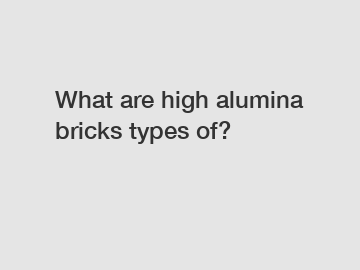What are high alumina bricks types of?
What are high alumina brickshigh alumina bricks types of?
High alumina bricks are essential refractory bricks commonly used in industrial applications where resistance to heat and wear is required. These bricks are made from high-grade bauxite clinker as the main raw material, along with other additives to enhance their properties. Let's explore the different types of high alumina bricks and their specific applications.
1. Standard High Alumina Bricks:

Standard high alumina bricks have an alumina content ranging from 48% to 80%. These bricks exhibit excellent thermal stability and strength due to their high alumina content. They are commonly used in various high-temperature environments, including furnaces, kilns, and incinerators. Standard high alumina bricks are suitable for applications that require good resistance to alkali and acid slag erosion.
2. Low Creep High Alumina Bricks:
Low creep high alumina bricks are designed to resist deformation under high temperatures. They have an alumina content of 70-85% and exhibit low permanent linear change even under prolonged exposure to high temperatures. These bricks find applications in industries where temperature fluctuations are significant, such as in steel, petrochemical, and cement manufacturing. Their low creep properties ensure dimensional stability and extend the service life of the refractory lining.
3. High Alumina Clay Bricks:
High alumina clay bricks, also known as fire clay bricks, are made from low-alumina clay combined with high alumina content. The alumina content ranges from 40-48%. These bricks offer excellent thermal shock resistance and high-temperature strength. High alumina clay bricks are widely used in blast furnaces, reheating furnaces, and boiler linings.
4. Phosphate-bonded High Alumina Bricks:
Phosphate-bonded high alumina bricks consist of high alumina aggregate and phosphate-based binding agents. These bricks have a higher alumina content of 85-95% and exhibit superior strength, resistance to thermal shock, and abrasion. Due to their exceptional properties, they are extensively used in the lining of cement rotary kilns, electric furnaces, and non-ferrous metal furnaces.
5. Corundum High Alumina Bricks:
Corundum high alumina bricks are manufactured using high purity corundum as the main raw material. They have an alumina content above 90%, making them one of the most heat-resistant high alumina bricks available. These bricks possess excellent corrosion resistance, anti-erosion ability, and thermal shock resistance. They find extensive applications in high-temperature furnaces, such as glass melting kilns and steel ladles.
In conclusion, high alumina bricks come in various types, each specifically designed to cater to different industrial requirements. Their alumina content and unique compositions determine their thermal and mechanical properties, making them suitable for specific applications. From standard high alumina bricks to corundum high alumina bricks, there is a wide range of options available for various high-temperature environments. Choosing the appropriate high alumina brick type based on the specific operating conditions ensures optimal performance and extended service life.
For more information, please visit industrial furnaces refractory bricks, castable refractory cement.
219
0
0

Comments
All Comments (0)